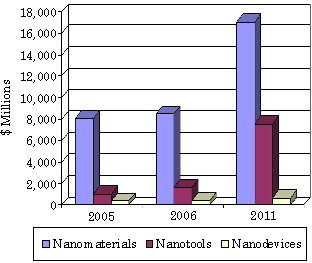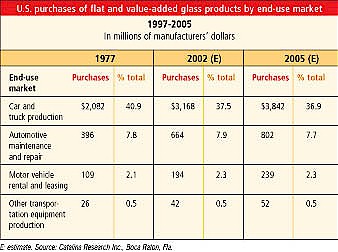|
Component Three
Provide a forecast of what the workforce demand would be over
a five-year period to produce and market your teams technical application or process.
Include the impact such production would have on the marketplace.
Nanotechnology, considered "the
next revolutionizing frontier of science", is an advancing industry facing
rapid growth in the next five years. Projected to become a
$1 trillion per year industry, research and development for these technologies
is actively being financed by the
governments of Japan and the United States. New developments can be expected
to generate global growth in a variety of fields. Our product will most likely increase
demand for employees in the nanotechnology industry.
In the automobile manufacturing industry, flat glass producers made $3.8 billion dollars in 2005. Enhancements to glass like our product will supplement existing products,
producing no apparent increase in consumption. A minimal impact on employment in
the glass manufacturing sector would be expected with a marginal increase in employees
who would specialize in the application of our product.
Our product with the potential to reduce accidents may become federally mandated
or may be required by insurance companies in new vehicle models. A comprehensive requirement
like that would dramatically increase our products deployment and reduce the manufacturing
costs on an economy of scale. The automobile industry as a whole will utilize nanotechnologies
like our product in order to become more cost effective. This trend can be seen
in the graph below.
Overall nanotechnologies are going to revolutionize the technology sector of the
economy, leading the way to developments like our product. The greatest growth will
be concentrated in the countries currently investing in research. The enhancements
in safety, and driver comfort from the reduction of glare will secure our product
as a valuable automotive feature for many years to come.
Give two examples of undergraduate or graduate degree programs
in science or engineering that directly relate to your team's NCT technical application.
For each program, be sure to include the following:
 the URL address of the institution, the URL address of the institution,
 the department (for example,
chemical engineering, electronic engineering) where the program is offered, and the department (for example,
chemical engineering, electronic engineering) where the program is offered, and
 a brief description of the
program of study. a brief description of the
program of study.
Due to the scope of our project, we felt it was necessary to examine three undergraduate
programs to solidify the varied pre-requisites present in our technical application.
Schools of Electrical and Computer Engineering, Physics, and Materials Science and
Engineering
Optics and photonics will play a critical role in enabling the
development and refinement of manufacturing during the 21st century.
Optical engineers use the discoveries of scientists to design and create optical equipment that advances industry and
improves life by making products that are safer, faster, and easier to use. Click
on each course title to see a detailed description.
-
MSE 3015 Electrical, Optical, and Magnetic Properties of Materials
Introduces the quantum mechanical concepts and the band theory of solids at the
level necessary to understand the physical properties of materials. Provides students
with a fundamental understanding of the important physical (electronic, dielectric,
optical, and magnetic) phenomena in various classes of materials (metals, semiconductors,
ceramics, and polymers).
-
ECE 4500 Optical Engineering
Introduction to applications of geometric and physical optics to engineering, including
optical measurements, matrix methods, instruments, interference, holography, beam
optics, Fourier optics, and diffraction.
-
PHYS 3225 Modern Optics
Principles of wave propagation, coherence, polarization, diffraction, and Fourier
Optics. Laser theory including the interaction of light with matter.
-
PHYS 4220 Optical Design
Principles of optical and optomechanical design including tolerancing, specification,
and thermal compensation of systems.
College of Engineering
North Carolina State's undergraduate program
in materials science and engineering focuses on understanding the structure,
modification and properties of materials, and the development of new or improved
processing methods. This program also offers the newest information for material
engineering to keep the students up to date with the new technology. Click on each
course title to see a detailed description.
-
MSE 200 Mechanical Properties of Structural Materials
An introduction to the atomic and grain structure of structural materials emphasizing
the mechanical properties. Effects of mechanical and heat treatments on structure
and properties. Fatigue and creep of materials, fracture toughness, mechanical and
non-destructive evaluation, effects of environment. Design considerations, characteristics
of metals, ceramics, polymers and composites.
-
MSE 230 The Impact of Materials on Civilization
Exploration of the role of materials in the development of modern industrial civilizations
by putting technology into a historical context and examining the advances made
possible by innovations with materials starting with the Stone age. Basic concepts
in materials science and engineering which focus on the relationship between processing,
structure, properties and performance. Material classes covered include metals,
ceramics, polymers, composites and semiconductors.
-
MSE 331 Electronic Properties of Materials
Treatment of the role of electrons and electron energy (band) structures in determining
the fundamental properties of materials- electrical, magnetic, optical, and thermal.
Introduction to quantum mechanics; Brillouin zones; band structures. Theoretical
and phenomenological basis of each property as manifested in various classes of
materials; examples and demonstrations of technological applications.
-
MSE 350 Mechanical Properties of Materials I
Covers fundamental topics in stress analysis and mechanics of materials including
statics and structures, elasticity, plasticity, fracture, fatigue, testing methods,
and engineering applications.
-
MSE 310 Computer Applications for Materials Engineering
Computer applications for processing and analyzing materials data and performing
materials design and modeling calculations.
-
MSE 450 Mechanical Properties of Materials II
Plastic flow, fracture and/or failure phenomenon in solids are treated in terms
of fundamental deformation mechanisms with emphasis on the role of crystal defects
and microstructure. Tensile, creep and fatigue modes of deformation are included,
along with design considerations and applications in-practice
Bachelor of Applied Technology
The Niagara College in Canada specializes in educating prospective students in the
field of
photonics. Students are trained in the development and technology of photonic
systems as they also explore the science of harnessing and developing light. Graduates
are prepared to pursue careers in optical coatings and optical hardware design.
Click on each course title to see a detailed description.
-
BATP9701 - Advanced Optical Theory
This course provides the student with a solid understanding of advanced optical
theory. Topics covered include: wave kinematics; geometrical optics; basic concepts,
ray-tracing and matrix formalism, Gaussian imaging by thick lenses, stops, and apertures,
and intensity relations; interference; interference spectroscopy and coherence;
diffraction: Fresnel-Kirchhoff formulation, Fraunhofer case, Fresnel case, and holography;
polarized light.
-
BATP9504 - Thin Film and Vacuum Systems
This course introduces students to the theory and practice of high vacuum systems
as employed in gas discharge tube processing (including laser tubes) as well as
thin-film deposition systems. Students will study the physical behavior of gases
and the technology of vacuum systems including system operation and design. Attention
will be paid to issues of gas purity and sources of contamination with residual
gas analysis and the broader technique of mass spectroscopy used analytically. Aside
from applications in gas discharge tubes, the other primary application of high
vacuum technology, thin film deposition, will be covered including evaporation and
sputtering techniques. The theory and design of optical coatings and structures
such as antireflective coatings and multilayer dielectric filters and reflectors
will be studied.
-
BATP9102 - Optics and Waves
In this course, students will learn about the physical concepts of energy, waves
and optics, using a combination of lectures and experimental (lab) investigation.
Students will study the principles of wave motion. Physical optics will be examined
as applied to refraction and reflection, lenses, prisms and mirrors. The electromagnetic
spectrum will be introduced, as well as, interference, diffraction and polarization
of light. In addition the quantum mechanical nature of light, photons and the photoelectric
effect will be investigated. This course introduces a calculus based treatment of
the material to be covered.
Develop an idea for a new science and/or engineering degree
program that might emerge given the advancements in scientific knowledge that the
team has identified. Provide a title and 100-word description of this new degree
program.
In addition to building a basic background in optical technologies and sciences,
our graduate program Optical Design and Manufacturing Technologies (ODMT) will enable our students to design,
manufacture, and modify our product. The research we conducted will hopefully instill
a better understanding of the optics, materials, and design involved in windshield
manufacturing. We have developed a comprehensive degree program for those who wish
to seek further education in this particular optics-based technology field.
|
Year One |
Year Two |
Fundamental Optical Theory
Polymer Chemistry
Fundamentals of Nanotechnology
Crystal Structural Design
Industrial Facilities Planning and Design
Internship
|
Optical Properties of Materials
Optical Engineering
Photonic Chemistry
Applications of Optical Nanotechnologies
Nanotechnological Manufacturing
Internship
|
|
|
|
Electives |
*Thin Films and Anti-Reflective Coatings
*Systems and Material Engineering
|
*Composite Materials and Technology
*Chemical Concepts in Materials
|
When asked what sort of college classes or previous work experience one would like to see on the resume of someone who wished to apply for a job that would incorporate a new feature in a current product, Mr. Rob Vandal, the Director of Advanced Product Development at Guardian Industries, replied, "We are looking for people who can plan and implement automation or techniques, meaning engineers and technicians."1
Also when asked about which personality traits that he would like to see in an individual wishing to work for him, he answered, "We look primarily for positive attitude, strong work ethic and as a result like to see that students have engaged in some real work during their time as a student. It is nice if it is related to their discipline ...
individuals that do well are very self motivated with a high level of
dedication."2
|
 Product
Product
 Liquid Crystals
Liquid Crystals Moth-eye Gratings
Moth-eye Gratings Photonic Crystals
Photonic Crystals Laws
Laws
 Manufacturing
Manufacturing



 the URL address of the institution,
the URL address of the institution,





